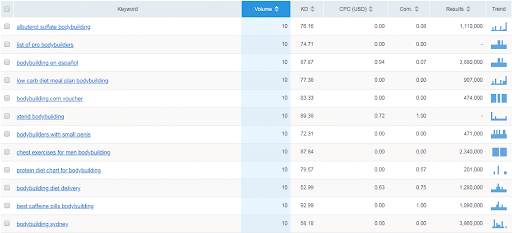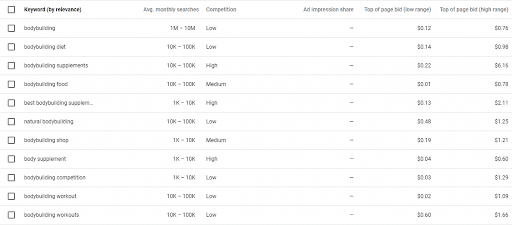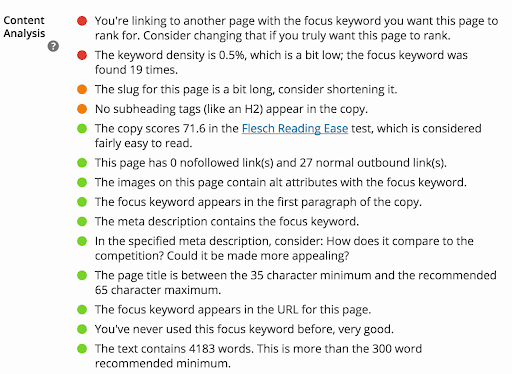If you are planning to build a content team in-house or you wish to outsource your content writing to an agency. This guideline will come to your rescue.
This guideline covers all aspects of educating a content writer, setting the right content delivery expectations, making them understand your audience and covering all SEO best practices.
In the end of the document, this guideline is available for download too.
GO STRAIGHT TO DOWNLOAD
This is how your content writing guideline can look like.
About #yourCompany: Add details about your company, your goals, visions, objectives clearly for the content writer to understand.
Services: List all your services and product offerings and point out your top product offerings
Audience Overview: Give a one line description of your audience. Such as “mid-market b2b saas companies in healthcare industry”
You can have more than one persona type. Make sure you explain each of them so they know who they are writing the content for.
Also mentioned the details of an individual persona below to give your audience a face.
- Industry:
- Role:
- Employees:
- Market:
- Revenue:
- Demographic:
- Location:
- Pain Points for my audience:
SEO Rules to Swear By:
There are top three rules every blog post must be written for:
- Create longer, more informative, more engaging content. All blog articles need to be 1500 - 2000 words
- Link to sites with high domain authority (use target=“_blank” to ensure external links open in a new tab — this helps improve time on site and bounce rate)
- Make sure you’re using keywords in headers, image alt text, meta descriptions, multiple title tags, Call To Actions, choose the right categories for the blog
- Reference blog links to understand writing style:
-
- Mention links to some reference blog styles that you would like to follow. This can be an industry leader or competition blog posts.
-
- How to Structure your article:
-
- Flow of your content should capture readers’ attention and guide them to the conclusion that you can help solve their challenges.
-
- Identify the problem your target audience is facing. Research your personas to determine what their goals are — and what’s keeping them from achieving those goals.
- Address your audience’s pain points. Write about the issues your target audience is likely facing.
- Provide an actionable solution. Here’s where you resolve those pain points. This is a great opportunity to create a complete step-by-step guide to overcoming a particular challenge.
- Exceed their expectations by giving something away to aid their journey. Maybe your reader isn’t ready to convert yet, and that’s fine! Keep their interest by providing something else of value. That could be a link to another article that’s relevant to their goals, a registration link for your newsletter, an ebook — the sky’s the limit!
-
- Punctuation Rules
-
- Semicolons: Here is a lesson in creative writing. First rule: do not use semicolons. They are transvestite hermaphrodites representing absolutely nothing. All they do is show you’ve been to college.” So, don’t use semicolons in any of the blogs you write — they just alienate the reader and make you look pretentious.
- Exclamation marks: Really, try not to use them. Most of the time, they only succeed in making the writer look cheesy. When you do use them, never put two in the same paragraph (or at the end of one paragraph and the beginning of another), and limit yourself to a max of two per page
- Quotation marks: “Always put your punctuation inside your quotation marks,” Joanie said. “Leaving them outside of the quotation marks like this”, she continued, “is never appropriate.”
- Parentheses: If you’re writing a sentence and want to use parentheses (like I’m doing now), the punctuation always goes on the outside. Notice where I put the comma in my last sentence? If you’re ending your parentheses at the end of a sentence, the punctuation still goes on the outside (like I’m doing here). Also, don’t use too many of them (like I do).
- Hyperlinks: If you’re writing a blog and talking about specific businesses or websites, hyperlink to them. Please note, “http://en.wikipedia.org/wiki/Hyperlink” is not a hyperlink. Don’t be lazy — make it look nice!
- Hyphenation: If you’re not sure whether you need to hyphenate words, Google it real quick. For the record, e-mail is always hyphenated. Other such words are cost-effective etc.
- Capitalization: Don’t capitalize insignificant words (the, of, and, etc.) in titles, unless they’re the first word, natch. Resist the urge — this is a common error! Also, there’s no need to capitalize the keywords that you’re trying to incorporate into your copy. If you’re trying to target the keyword “social media management,” it shouldn’t be capitalized awkwardly. “These five Social Media Management tips will help get your Internet public relations campaign off the ground,” is not the right way to write it out — it just draws attention to the fact that you’re trying to be sly about keyword stuffing while content writing. Instead, capitalize things naturally and the reader will focus on what you’re saying, not your poor SEO content writing skills.
- Internet and web: Internet is a lot like America, in that it’s always capitalized. Whether it’s the first word or the third, it’s still a proper noun. Unlike Internet, web is not capitalized. Web should only be capitalized when it’s the first word of your sentence.
#explain here how to write your company name.
- Commas: Don’t be afraid to use them, but don’t use Oxford commas. It’s “red, white and blue,” not “red, white, and blue.” That red comma is of the Oxford variety, and they’re outdated and redundant
- Numbers: One through nine should always be written out, write out 10 and above in numbers.
-
- Your company Style debate
-
- Company name uses the singular, gender-neutral “they” or “their company” and speak in one on one manner with the reader like “i am writing this email…” or “I recommend having a team…”
-
- Try using short simple sentences to get attention, then longer more complex ones to flesh out ideas. Use interesting verbs to highlight important actions, then more conventional ones for variety.
-
- These small changes won’t add to your word count, but they will make your content writing more exciting and engaging.
-
- Put simply: keep it short! A five-line paragraph is great, but a three-line paragraph is even better.
-
- SEO Best Practices
-
- 1. Always start with keyword research for SEO
-
- Before you even start to write content, you need to know what you’re writing about — and you can kill two birds with one stone if you combine search engine optimization with your editorial calendar planning.
-
- It illuminates your competitors content strategy, and highlights the strengths and weaknesses in your own. And it allows you to optimize individual articles and your content strategy as a whole to bring in more traffic.
-
- How to Use SEMrush for Keyword Research and Analysis
-
- SEMrush is a complete end-to-end SEO platform, but for you to understand and keep things simple, we’ll focus on using its use as a keyword research tool. Search for a keyword in Keyword Analytics to receive an auto-generated list of related keywords with their volume, keyword difficulty, CPC and competition. Phrase Match gives you keyword queries that contain “bodybuilding,” while Related Keywords provides more keywords that may or may not contain the term.
-

-
- You can filter these results to include or exclude certain words, then export them to a spreadsheet for your master keyword list.
-
- Another way to use SEMrush for keyword research and analysis is to see what your competition ranks for — this would be impossible using the manual method!
-
- Use the Domain Analytics feature to input your competitor’s domain, click Search, and you’ll receive a list of keywords your competitor ranks for, along with how well they rank for those keywords, the URLs that landed them those SERPs, competition and keyword volume.
-
- How to use google for keyword research
-
- Here’s the old-fashioned way of researching keywords, using “bodybuilding” as an example. Search for “bodybuilding” in Google Keyword Planner, then click “Get Ideas.” Google will provide you with 436 related search queries, which you can then export that into a spreadsheet for a master list.
-

-
- You can also use Google itself, looking for “related searches” at the bottom of the page.
-
- Copy and paste those terms into your master keyword list. Bolded words in those related searches (for example, “workout routine,” “supplements,” etc.) are semantically related, and valuable to include in your content.
-
- 2. Keyword stuffing is never okay
-
- Keywords are a means to make your content valuable, readable and search-friendly. But when you start cramming in keywords, it does the exact opposite.
-
- A web page stuffed with keywords looks dubious and untrustworthy — to both Google and human readers. Your conversion rate and SERPs rankings go down, along with your pageviews.
-
- Readers start to see it as a low quality page and bounce quickly, and over time search engines slap down your domain.
-
- Search engines are smart these days. You don’t have to work in grammatically incorrect keyword phrase just because searchers use it. You don’t need to work in every conceivable variation of a search term for Google to understand what your page is about.
-
- 3. Drive toward powerful calls to action (CTAs)
-
- Before you even start writing, you need to know what your call to action will be, and you need to make it compelling enough that readers can’t help but click. That’s how you connect content writing to marketing goals and prove ROI.
-
- Which calls to action should businesses use in their content?
-
- Here are some examples of calls to action you can incorporate in just about any blog post or landing page:
-
- Desired user action: download resource/ebook. Download our free guide for more expert tips about [topic].
- Desired user action: subscribe to newsletter. Sign up for exclusive resources in your inbox each week.
- Desired user action: share content on social media. Know somebody who could use these tips? Share this article and tag your colleague!
- Desired user action: get free consultation
- When writing calls to action, put yourself in the reader’s shoes: what would it take for a company you’ve never heard of to convince you to do something, even something as simple as sharing the article with a friend?
-
- Now, connect it to your goals: how can you craft a CTA and content specific to your company’s marketing and sales KPIs that actually persuades readers to take action?
-
- 4. Always hyperlink to your sources
-
- When you reference another website’s content, make sure you hyperlink back to that site. Always choose the “open link in another window” option.
-
- Besides being the right thing to do, citations can also help you get backlinks.
-
- Frequently, the sites you link to will see your effort and thank you for it with a reciprocal link or quote
-
- 5. Make the reader feel something
-
- Next time you’re crafting a piece of ad copy or web writing ask yourself, “What’s good about this story? How can I give this more emotional impact?” Find it, and you might just have viral website content on your hands.
-
- But almost all viral writing shares one thing in common: emotional impact - Importance of creating web content that evokes an emotional response.
-
- 6. When writing for the web, chop it up.
-
- Attention spans online are a LOT shorter and your paragraphs need to reflect that.
-
- Put simply: keep it short! A five-line paragraph is great, but a three-line paragraph is even better.
-
- Don’t worry if an idea doesn’t seem to be fully “complete” before hitting that enter key. Err on the side of short paragraphs and chop it up!
-
- 7. Update your links
-
- We know the importance of internal links. Linking to other pages on your site boosts SEO, gives readers useful info, and increases page views and time on site. However, it’s not enough.
-
- You need to revisit older posts and pages to update them with new links. This boosts your search results, makes your pages more useful and relevant to users and helps your content stays fresh.
-
- 8. Use keywords in headings
-
- Repeating your targeted keywords a couple times isn’t enough — you need to use your keyword (and related phrases) anywhere it fits: in the url, H2 headers, meta description and even in the alt tags of your images.
-
- Once you’re finished inputting your content, expand the Yoast box and check out the Content Analysis portion for some helpful hints about what you should improve before you publish.
-
- Not only does Yoast nail big problems like missing keywords in the meta description, it can also help you zoom in on granular issues like low keyword density to give your site an extra SEO boost:
-

-
- 9. Give your readers a reason to care from the first sentence
-
- Good intros are hard. It can feel unnatural to skip right to the point. You want to provide some background, warm the reader up and then work your way to the main topic when you feel ready.
-
- But by that point, your reader is long gone.
-
- Your website isn’t literature. Site visitors aren’t there for your nuanced language or slow, measured flow. They’re there to get information or solve a problem.
-
- And if you don’t give them a reason to care about your article, they’re going to get that information or solve that problem somewhere else.
-
- Every piece of content you write should tell your readers why they should invest their time in hearing what you have to say. How will what you’re teaching them help them? What goal will they accomplish with your help? Why should they care?
-
- 10. Revamp posts for maximum value
-
- Good web content gains value over time. That means there is no such thing as a “set it and forget it” content strategy
-
- How to Edit Old Blogs to Increase Organic Traffic
-
- What you can do to make the high ranked content even juicier for search engines. Here are three ways to do just that:
-
- 1. Bump up the word count.
-
- If the blog post you’ve selected has less than 2,000 words, one simple way to increase organic traffic is to increase the word count — but don’t just fluff it up. Make sure any content you add also adds value. Instead of watering down paragraphs, add completely new sections that cover points you haven’t introduced yet. Chances are, the added word count will allow you add additional keywords. Speaking of…
-
- 2. Increase keyword density.
-
- Input your post’s url into SEMrush to discover the keywords that it’s already ranking for. Are you ranking just off the first page of the SERPs for any specific keywords that have a high search volume?
-
- Take a look at the keywords which are ranking in positions 2-10 and try optimizing for these first — moving from third to first position for a term with high search volume can drastically increase organic traffic. Plus, it’s easier to bump a page up the SERPs when it’s already ranking for that keyword.
-
- Once you’ve identified a relevant keyword target, add in it — but don’t stuff the page. Only use additional keywords where it makes sense.
-
- Don’t forget to hyperlink these keywords to other relevant blog posts you’ve written, and incorporate them into headings and sub headers (use those H2s!) for increased SEO oomph.
-
- 3. Target similar keyword strings.
-
- If your page is ranking for a keyword like “social media management,” you might want to look into similar long-tail keywords, such as “social media management pricing” or “social media management tools.” Chances are, adding in sections that address these subjects will be fairly easy. Additionally, by adding in a few extra long-tail keywords, you’ll have the added bonus of increasing the total keyword density of the page.
-
- Download the content writing guideline here
-
- Let me know in the comments below, if this was helpful.


